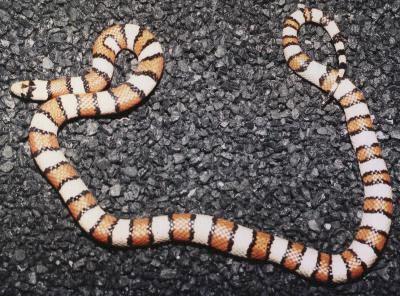

Milksnakes will also eat other small mammals, eggs, birds, reptiles, fish, amphibians, and invertebrates. These human-dominated habitats often support high numbers of rodents, which is one of the main sources of food for adult Milksnakes. Milksnakes move frequently throughout their home range using corridors to access breeding sites, basking areas, and areas for hibernation known as hibernaculum. Milksnakes are opportunistic and will inhabit buildings found in rural areas such as barns, sheds, houses as well as utility corridors, suburban parks and gardens. They prefer areas near a source of water that also have cover for egg-laying and hibernation. The species can be found in areas with high forest cover as well as open habitats such as prairies, meadows, pastures, hayfields, and rocky outcrops. They can be confused with young eastern ratsnakes, young northern racers and young northern watersnakes.Eastern Milksnakes inhabit a wide range of both natural and human-modified habitats. The eastern milksnake is often mistaken for a copperhead. They want nothing more than to be left alone. If you see a dangerous snake, move away slowly. To avoid bites, don't bother or approach snakes, and watch where you step.

Even though they used to be referred to as "checkered adders" by some, they are not venomous. They may also vibrate their tails to produce a buzzing sound and release musk when threatened. They will coil, hiss and strike, and bite if cornered. This is not true, the snakes were after rodents that often live in barns with livestock.Įastern milksnakes do not want to interact with humans and will try to avoid them.

People started believing that they liked cow's milk and would suck on the cow's teats. Eastern milksnakes got their name because they were frequently seen in barns where cows lived. They wrap an animal in their coils and squeeze until the animal suffocates. They hibernate in the winter and emerge in in April or May.Įastern milksnakes eat small mammals, small birds, and smaller snakes. Eastern milksnakes usually warm themselves by soaking up heat from the underside of sun-warmed objects rather than basking in the sun. Snakes cannot regulate their body temperature internally. The 8 1/2 inch young are colorful with rusty-red blotches.Įastern milksnakes are out during the daytime in spring and fall but become nocturnal during the warmest months. The baby snakes use a special "egg tooth" to hatch out of their eggs in August or September. Temperatures in the range of 65 75 degrees are easily tolerated. Generally prefer temperatures a little lower than most milksnakes, probably an adaptation for the high elevations from which they come. The mothers do not care for their eggs, but leave them to hatch on their own. In the wild adults seem to be relatively docile and are easily followed, whereas juveniles are very flightly. Several females may lay eggs in the same spot. Females will usually lay 6 to 18 eggs in June in sheltered spots that provide some warmth such as in soil, rotting vegetation, or decaying wood. Mating season is around late April to May in New England. They are usually under the cover of logs, stones, boards, or stone walls. In Connecticut the eastern milksnake can be found all over.Įastern milksnakes can occupy habitat that ranges from urban areas to forest. The maximum total length recorded for this species is 132 cm, although normal lengths range from 60-90 cm. The Eastern Milksnake, Lampropeltis triangulum is tan, brown or grey and has large, black-outlined, red or brown dorsal blotches that fade as the snake ages. It extends westward to western Kentucky, southwestern Indiana, northeastern Iowa and south-central Minnesota. Wildlife Species Description and Significance. The range of the eastern ratsnake in the US is from southern Maine to northern New Jersey and in the Appalchian mountains through North Carolina, Tennessee, and northern Georgia and Alalbama. It is a slender snake and its head is only slightly wider than its neck. It has a black and white checkerboard belly. It can be mostly gray, mostly, brown or more reddish. It has a whitish-gray body with red, brown, tan or black on its back. The eastern milksnake can be varied in its coloration.


 0 kommentar(er)
0 kommentar(er)
